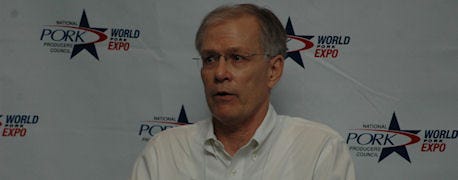
In the nearly three weeks since the positive identification of Porcine Epidemic Diarrhea Virus, or PEDV, in the United States, the National Pork Board has approved $450,000 in Checkoff funds to help speed research into finding answers to this new threat facing the domestic pork industry.
"The National Pork Board took this action to help get answers to U.S. producers as quickly as possible to help protect their herds from this devastating disease," says Conley Nelson, National Pork Board president and producer from Algona, Iowa. "Because of the investment producers make as part of Checkoff, we're able to respond quickly to sudden disease threats such as this."

FIRST PRIORITY: Dr. Paul Sundberg says the first priority, concurrent with providing producers with necessary information to protect against PEDV, is to identify how the virus came to the U.S. "If this virus got into the country, we need to do everything we can to find that door and shut it."
According to Dr. Paul Sundberg, the Pork Checkoff's vice president of science and technology, PEDV, a disease that affects young pigs, is not a new virus outside of the United States. "It's a disease that has been around the world in many different places," he says. "Since PEDV is widespread in many countries, it is not a trade-restricting disease."
PEDV is also not a food safety concern, but rather a production-related disease. As of June 6, 103 cases have been reported as far east as Ohio and as far west as Colorado.
Sundberg says certain states and regions have not had the disease. Though it appears to be similar to transmissible gastroenteritis, reports show it spreads quickly within a farm.
"With TGE, you can see it spread," he says. "Although there can be different clinical presentations, what we’ve been hearing is that most of the time with this, it spreads so quickly, everyone gets it at once."
PEDV prevention research priorities
The first priority is to identify where it started. "If this virus got into the country, we need to do everything we can to find that door and shut it," Sundberg says. Concurrent with that, providing producers information they need to learn how to handle it and prevent it from occurring in their farm and from spreading. "The effort right now is to help the U.S. producers with what they need to have in order to understand this."
"As with all of our research, we want it to be transparent and objective," Nelson says. "And in this case, it must be very specific with quick turnaround times so that we can get answers quickly."
At this point, not much is known about the impact the virus could have on a farm. "We're really only about two weeks into this, and it's changing every day that we go," Sundberg says. "Unfortunately, there are a lot more questions than answers at this point."
About the Author(s)
You May Also Like






